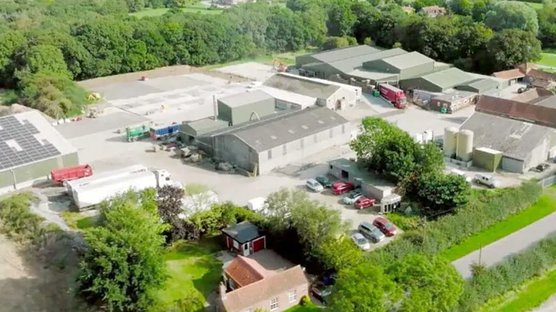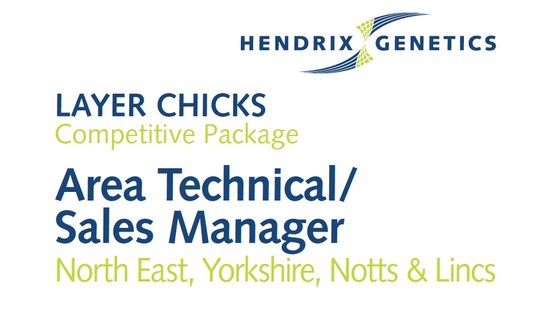
Published on Oct. 10, 2023
Bovans Brown Flocks Thriving in a Unique Off Grid Free Range Set Up
For the last five years the Craven family have relied on back-to-back flocks of Bovans Brown layers
Based near Boston in Lincolnshire AR Craven Farms Ltd diversified into free range egg production in 2009, with their first flock of 32,000 free range layers. Today, brothers Tom and James Craven, together with their father, Andrew, run a carefully integrated business, combining arable farming, egg production, and a transport business.
In 2022 their third shed came on stream, housing 64,000 birds. Run entirely off grid, in a brave and innovative first in poultry farming, the poultry house uses a unique combination of solar power and battery storage to provide all their energy. This ground-breaking solution was brought to fruition with the close cooperation and careful research by AR Cravens solar energy partner, BeBa Energy.
The rural community has traditionally been at the forefront of renewable energy deployment and solar power is no exception. “We are proud to work with farmers of all sizes across the country to support them with their diversification projects. BeBa Energy understand and respect the unique characteristics of a rural project, and our work to date is testament to this. Since 2010 we have delivered projects for some of the UK’s most well-respected agri-businesses” Darren Oliver of BeBa Energy explains.
Layers really stacked up as a proposition
Brothers Tom and James were only 13 and 15 respectively when their father made the decision to diversify from traditional arable farming into egg production. As James recalls “We already knew Fairburns who were based just down the road, so my father sought their advice and started our journey based on their recommendations. Poultry production was particularly attractive to us because we planned to use our own wheat for feed and our own transport to take it to and from the mill. Added to the fact that we can use the muck from the poultry sheds, layers really stacked up as a proposition. Ultimately it takes the volatility out of wheat prices and as a package makes it a much more risk-free business”.
From the start the business was joined by Sandra Bourne. “We were complete beginners in the early days” James admits “and Sandra brought a wide cross section of invaluable poultry experience to help us through the learning curve. Fortunately, she has been with us ever since, and we have all grown together. Similarly, right from the outset we have bought pullets and feed from LJ Fairburn and all egg production is sold to them” says James “They are only 10 miles away and it’s a longstanding relationship that relies on a lot of trust. We sell wheat to them, sending six loads a month, and I believe we are one of their largest producers”.
Starting in 2009 the first flock of 32,000 birds were housed in a Vencomatic Bolegg gallery system. Bolegg gallery systems are equipped with egg belts, enabling automatic collection of all eggs. A tipping floor closing mechanism prevents littering the nest at night and allows dirt and dust to fall off easily when closing the nest. The system offers a hygienic environment through the combination of the nest and the wire mesh floor.
In 2016 the second shed was built to house 64,000 birds, this time in a Vencomatic veranda gallery aviary system. Designed around freedom of movement and welfare, and with input from the RSPCA, the Veranda gallery aviary system was launched following studies at the University of Bristol and the Dutch University of Wageningen.
Back-to-back flocks of Bovans Brown
For the last five years the Craven family have relied on back-to-back flocks of Bovans Brown layers, hatched by Hendrix Genetics’ UK distributor, Joice and Hill. Having tried Hy-Line and Lohmann in the past James is happy they have found the breed that suits them best.
“The Bovans birds lay well and are particularly easy to work with” James says “The Bovans Brown layer has a reputation for persistency and strong performance at the end of lay, and this has certainly been our experience. We used to deplete flocks at 76 or 78 weeks, but due to a variety of unplanned factors, including AI, we took flocks to 86 and then 82 weeks. At end of lay, the last six weeks come at very little cost, and we will happily continue to deplete at 82 weeks” he adds “Bovans reliably peak at 96% and then tail off more slowly than other breeds”.
Long-term relationship with Joice and Hill
In common with their other key relationships, AR Craven value the advice and trust that has been built up from the long-term relationship with Joice and Hill. Initially working with Peter Cumbers, and then with Peter Rogerson, James got on well with both, appreciating the weekly visits when the birds are young and the fact they maintained contact along life of flock. Continuity in technical back up is now provided by Will Judson, Area Technical Sales Manager Northeast, Yorkshire, Notts & Lincs.
The off-grid solution
In 2022 the business took on its most ambitious and innovative project. Plans to build a second, brand new 64,000 bird shed, led them to the off-grid solution. “We felt we understood layers and had plenty of wheat, so we decided to build a new shed” James told us “When we discovered that the utility connection charge alone would be circa £60,000, it made us question how best to provide energy to our third house. We spoke to Kevin Howes of Vencomatic UK, who said he was aware of battery system in its early stages of installation at a poultry site elsewhere in the UK. So, in conjunction with BeBa energy, we set about designing a solar and battery system for us. However, our system would be different, potentially riskier, because it had no grid connection as back up.
“Security of supply in the absence of enough sunshine, would be provided by a generator. Solar panels charge the batteries, and the batteries power the shed. The back-up generator starts to charge the batteries if they fall below a certain level, but it doesn’t run the shed directly. The generator will only charge the batteries to 40% but last year the generator was only needed for 700 hours. That might sound like a lot, but its less than 14 hours per week”.
All this technology came at a substantial cost, but the family were confident it stacked up against a more traditional solution. As James puts it “This was back in 2019, and it just about added up, depending on predicted battery life, which were budgeted to last 10 years. However, now that energy costs have soared and the battery manufacturers are confident of longer life, payback predictions and returns are now significantly improved. The timing was more a matter of luck than judgement, but despite a lot of late-night calls, we take huge personal satisfaction out of doing something that hasn’t been done before– it’s fantastic really”.
Reduced energy consumption was also behind the decision to revert to the Vencomatic Bolegg system. As James explains “We preferred the Bolegg system. It is simpler with fewer motors to go wrong and better, more even ventilation, and of course, fewer motors mean less electricity and less battery use!”
When asked about the future James says there are no immediate plans to expand. “Out of 4,000 tons of wheat production half goes to produce feed for the layers, and we think that’s the right balance. We have thought about rearing our own pullets, but we get good well reared birds already. We would be interested in farming white birds, but Fairburns don’t currently offer a white egg contract. There are also long-term discussions around an “eco brand” and we would certainly like to be part of that. So, ask me in three- or four years’ time” he concludes.



